Resources and Raw Materials
Resources and Raw Materials are generally either harvested from the lands or obtained by killing Mobs, and are used as ingredients for crafting. Some are very rare, others extremely valuable, but for the most part they are all worth finding and hoarding.
Some of the resources in this section -- such as ingots -- are created by completing primary crafting stages on raw resources, but as they present as resources for the making, through secondary crafting, of finished goods, they still belong in this section.
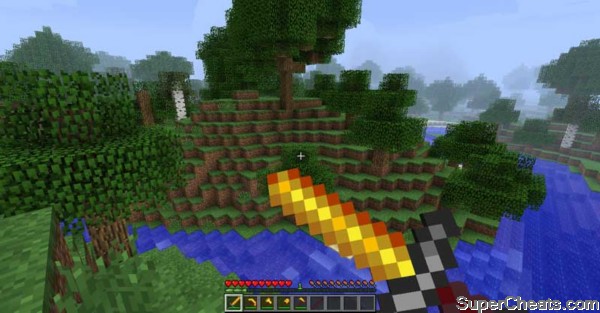
-- Blaze Rods
Obtained from Blaze Mobs (hence the name), Blaze Rods are a primary ingredient for crafting Brewing Stands, which are a desirable object in the game as they are used for brewing potions and. Additionally the Blaze Rod is a source for Blaze Powder.
Dropped from the Blaze, which are a mob found in or near Nether fortresses, obtaining this item is a very challenging proposition for most new players since they must first learn how to kill Blaze -- who shoot fire at the player and are fairly dangerous.
In addition to serving as an ingredient for other recipes, Blaze Rods can also be used as fuel for Furnaces; their burn duration is 120 seconds -- versus the duration for Coal, which is 80 seconds -- and once the player masters killing and farming Blaze, may very well be a preferable fuel, though Coal is rather easy to obtain...
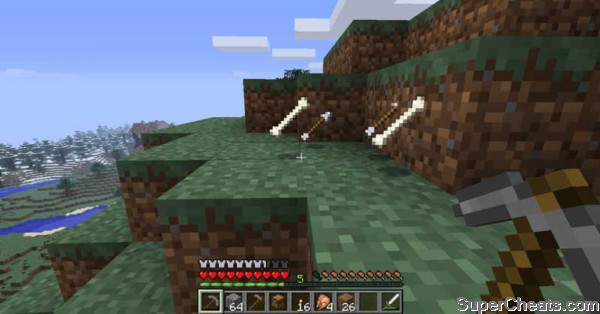
-- Bone
Bones are an incredibly useful item as they can be turned into Bone Meal, which allows the player to instantly grow some plants (such as trees) by applying it to them. They are dropped by Skeletons when killed either by the player, or by the sun when it rises, so it is likely that the player will encounter Bones as they explore, which are dropped when a Skeleton died at dawn.

-- Charcoal
Charcoal is an alternative to coal, and is obtained by burning Wood in a Furnace to creates Charcoal. It can then be used for any function in which you would normally use Coal, including crafting of torches, powering Minecarts, and smelting objects. Charcoal will not stack with coal, though the two appear to be identical save for their labels, sharing the same texture.
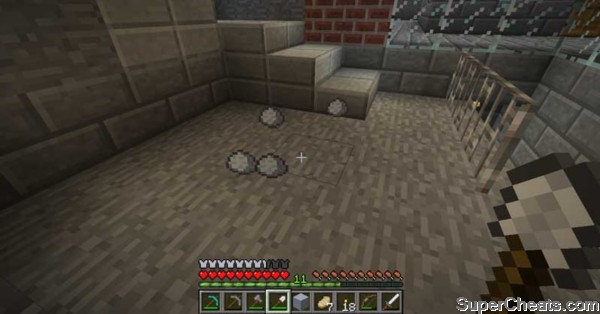
-- Clay Balls
Obtained as the direct product of mining Clay Blocks, which are found in shallow water, Clay Balls have several uses including crafting Clay Blocks and, when fired in a Furnace, creating Clay Bricks.
Clay is more commonly found in Swamp Biome, but can be obtained from other water areas. It can be mined with any type of tool, but Shovels are the most efficient tool for digging it up. Destroying clay blocks will yield 4 balls of Clay each, which can be crafted back into a clay block or smelted into brick.
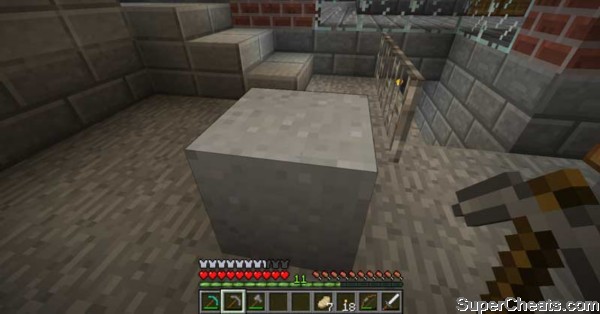
-- Clay Blocks
While these are encountered in and around water, and differ from Sand and Dirt Blocks by their distinctly purple hue, Clay Blocks cannot be taken from the water intact, they must be broken up into Clay Balls. The Clay Balls can, however, be reassembled into Clay Blocks for bulk storage purposes.
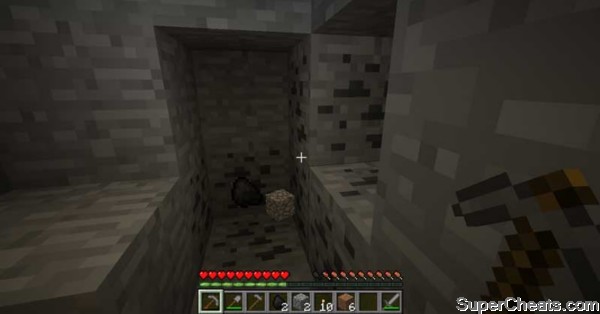
-- Coal
Coal lumps are harvested directly from coal ore blocks in the ground, which can be destroyed using any level of pickaxe to yield Coal -- it is found at any elevation, pretty much wherever there is stone, and it is a very abundant resource, appearing in large veins.
Coal is generally considered to be the most efficient fuel available for Furnaces, as a single piece of Coal will smelt eight units of ore, bake eight units of Cobblestone, or cook 8 units of meat. In addition to serving as fuel for the Furnace, Coal lumps (and charcoal) are the only fuel accepted by Powered Minecarts, the use in which providing around four minutes of power each.
Coal is also a critical ingredient in Torches, which are indispensable for below-ground exploration, mining, and providing light security in the construction of Strongholds.
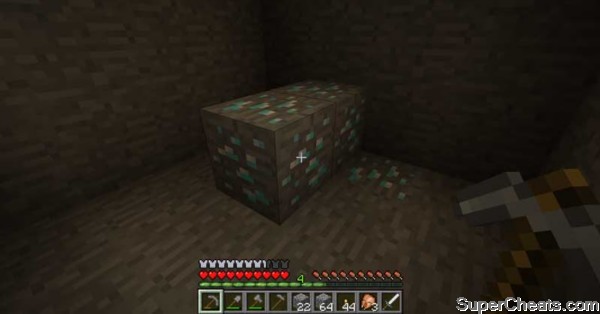
-- Diamond Gem
Considered one of the most valuable items in the game due to their rarity and usefulness as a crafting material, Diamond Gems are a priority item for mining and stockpiling for any player. They are obtained by mining a Diamond deposit underground with an Iron (or better) Pick, and have a wide variety of craft applications.
Diamonds can be used to make Axes, Hoes, Pickaxes, Shovels, Armor, Swords, Jukeboxes, and Enchantment Tables, and can also be turned into solid diamond blocks, which are incredibly tough. The Diamond Pickaxe is the only type of Pickaxe that can be used to mine Obsidian, which is why most players carry at least one when they are mining.
When seeking Diamonds be aware that they are ONLY encountered below level 18 (hit F3 to see your level) and are generally found small veins of 1 to 9 blocks, and can ONLY be mined using either an iron or diamond pickaxe. The rarity of Diamonds and the difficulty and effort that is required in obtaining them is such that it is not considered wise to waste them in crafting things you do not actually need -- making Blocks from them? Not so much.
-- Ender Pearl
The Ender Pearl is a very important item that is sometimes dropped by endermen upon death, and is used to create the Eyes of Ender -- the item that is required in order to reach the end game zone, The End.
In addition to being used to craft the Eyes of Ender, throwing an Ender Pearl will cause the player to teleport to wherever it lands -- but with the cost of 5 5 Hearts in falling damage. When the player reaches the other end of the teleport they are briefly surrounded by the flower-like particles Endermen create when they teleport which illustrates that process.
Ender pearls are necessary to craft Eyes of Ender, which are used to find strongholds and repair End Portals. Therefore, Ender Pearls are crucial to reaching The End.
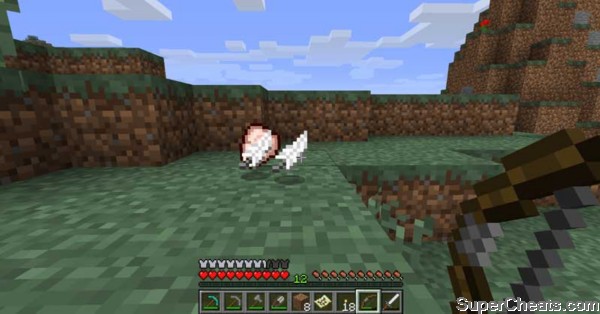
-- Feathers
Obtained from killing Chickens (who drop 1 to 2 Feathers each) stockpiling Feathers is a necessary task as they are one of the core ingredients for making Arrows -- something you will use a lot of.
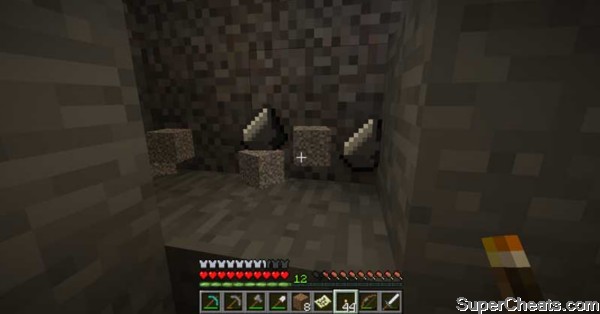
-- Flint
This dual-use resource is obtained by mining Gravel and is used for the crafting of Flint and Steel and Arrows. There is a 10% chance that a Gravel Block will spawn a Flint.
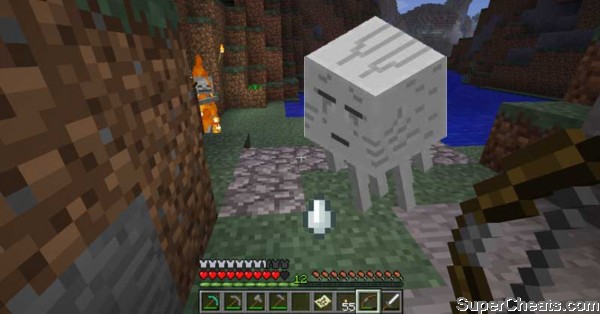
-- Ghast Tears
When a Ghast is killed they drop a single Ghast Tear -- and as Ghast Tears are used as a valuable primary ingredient for Brewing they are considered to be a very desirable resource. There is a catch though -- but you probably figured that out already, right? Or at least suspected?
Ghast are a flying jellyfish-like creature that occupies The Nether region (heh, did you get that pun?) -- in fact they can pretty much spawn anywhere in the Nether where there is room for them to spawn -- and did I mention that they shoot nasty fireballs as their primary attack? Yeah, they shoot nasty fireballs as their primary attack!
The Ghast were added in the Halloween Update, and represent a very good reason why you practice your archery skills and get really good with the Bow -- and a good reason for practicing and learning your Enchantment Skills and perhaps learning the language that the Enchanter's Table uses because you are going to want to put together a really good kit of enchanted weapons and armor if you are going to farm Ghast -- and you ARE going to farm Ghast, trust us on that...
Be warned, Ghast have a very long scanning range -- they can detect and attack a player from up to 100 blocks away -- but fortunately they do not have a primary pursuit mode and they lack a tenacious spirit... Can you imagine what a nightmare they would be if they did?!
Basic strategy for farming Ghast is to build a fireball-proof shelter in The Nether using the local brick and then pop-out and shoot them as the opportunity presents, ducking back inside to avoid their fireball attack. It really is as simple as that!
-- Glowstone Dust
Glowstone Dust is obtained by mining Glowstone Blocks (pictured above on the right) which are only encountered in The Nether (!) -- so you will want to be on the lookout for it as you mine and grab it (obviously)...
When you mine a Glowstone Block it breaks down into 2 to 4 Glowstone Dust (pictured o the left above) -- and you do not need to use a Pickaxe to mine it as that requirement was removed, though you still can use tools...
For ease of storage you can combine the dust back into a block, which allows you to store four in one, but bear in mind that there is no guarantee that you will get all four Dust back when you break the Block down...
Required in the crafting of Redstone Lamps, Glowstone Dust is also used to improve potion power effects, but at the cost of duration time, which its use reduces.
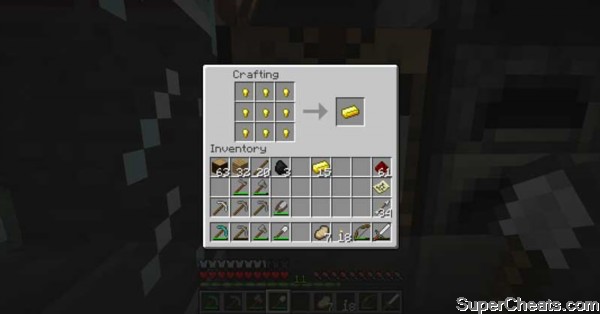
-- Gold Ingot
In the world of Minecraft Gold is the odd resource -- in the real world it has intrinsic value but in the game world its value is largely as a utility and resource for what it can make. Interestingly it is about as rare in the game as in the real world it seems, but our discussion of this particular resource should be underscored by its current state, which is to say that the form it takes is particular to your use of it, and in this state, as a Gold Ingot, its value to you is largely for the making of Clocks, Powered Rails, Gold Armor and Gold Weapons, as well as Gold Tools.
Of those items the making of a Clock or Powered Rails makes sense, but considering how weak and soft the metal is, and its very low durability, using it to make any of that, and especially considering how big a pain in the *** it is to acquire it in quantity, may not be the way to go. The exception to this is when you are doing very high-level Enchantment, because Gold armor, weapons, and tools will take the highest Enchantments.
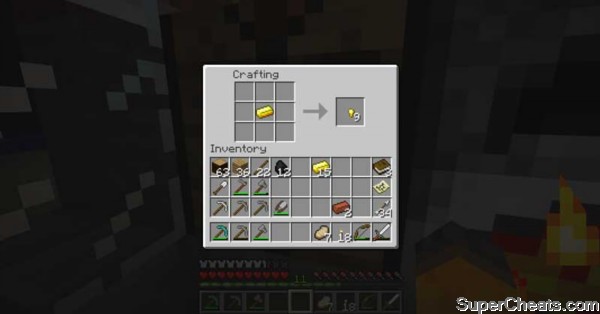
-- Gold Nugget
Found as loot on Zombie Pigmen, Gold Nuggets are a multi-use resource in that they can both be crafted into Gold Ingots, and can be used with Melon Slices to craft Glistering Melon (a Potions ingredient).
Of more interest to players is the fact that Gold Ingots are half of the recipe for Golden Apples, which are perhaps the most desirable food item in the game.
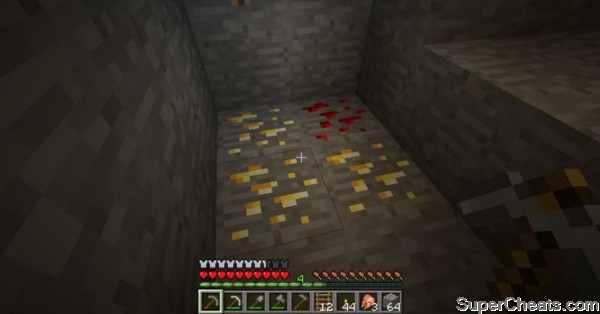
-- Gold Ore
Found in the bottom 32 layers of the map, Gold Ore is mined using Iron (or higher) Pickaxes and is used for a variety of crafting purposes once it has been smelted into Gold Ingots. It appears in areas among Stone, and often appears in groups of between 2 and 9 blocks of Ore. It is not uncommon to find Gold grouped with other resource types (as seen in the image above) and it is also not uncommon to find Gold close to Lava pools and Lava Source Blocks -- so care should be taken when encountering and mining Gold that you do not accidentally open a Lava flow, as that can easily kill you.
You may find it interesting to learn that Gold is the only material in the game that can be crafted into a tool that is not capable of mining itself -- the Gold Pickaxe will not properly mine Gold Ore.
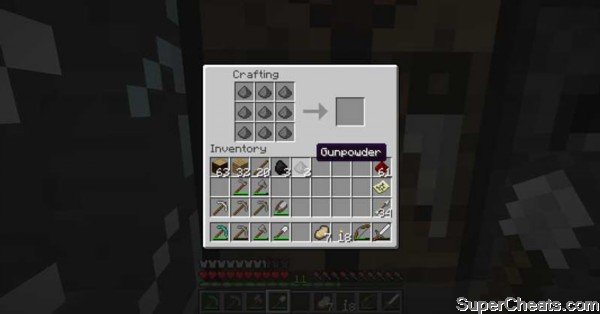
-- Gunpowder
You might think that considering how valuable it is, and how useful, Gunpowder would be one of the items in the game that the player could manufacture, if at considerable cost in effort, but that is not the case, as it is only obtained as loot either from killing Creepers and Ghasts, or from chests found in dungeons. Most players agree that it would be nice to be able to craft it, since it is used as one of the core ingredients for TNT, as well as Fire Charges. It can also be used for creating Splash Potions
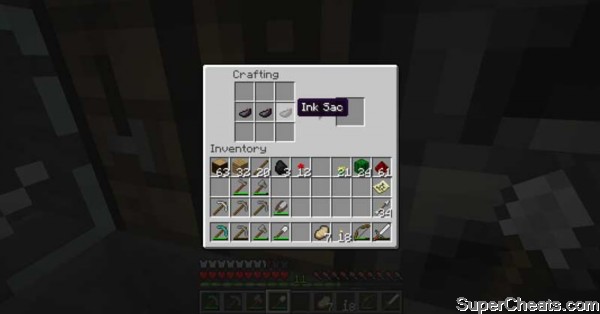
-- Ink Sac
Obtained by killing Giant Squids in the water, the Ink Sac is used pretty much for crafting Wool Dyes at the moment, and for mixing to get other shades of Wool Dye, but the word is that in a future update once the Xbox 360 version of the game is stabilized and brought up to the current revision, they will be expanding the capabilities of the Book object that is already in the game to allow players to write in them, and Ink will be required to do that... It has also been mentioned that the Wool Dye set will be used as the paint for the custom painting action that will be added in yet another future update, allowing players to paint their own paintings with which to decorate their homes.
At the present moment the Ink Sac, which is acquired by killing Giant Squids in the ocean, can be combined with Wool Blocks to make Black Wool, and can be used on a Sheep to make them a Black Wool Spawn; bear in mind though that Black Wool from Black Sheep are already a naturally occurring spawn in the game, so using the Ink Sac for straight dying of black for Sheep is of dubious value...
That being said, it is still useful for obtaining different shades of gray and lighter black, which you will find very useful if you are a mountain artist (a player who uses dyed Wool to "paint" images by stacking it on the side of a cliff or mountain. This is also of significant value to gamers who practice the hobby of Spleef Stadium Design.
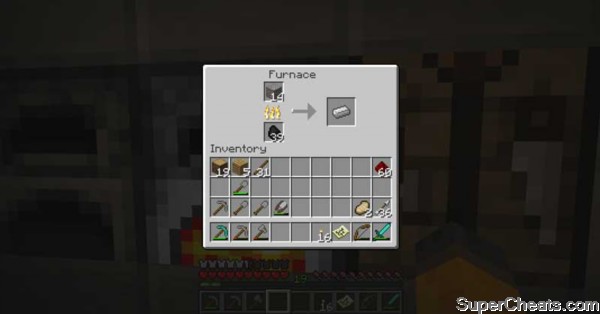
-- Iron Ingot
Considering that Iron Ingots are the most commonly used and desired crafting resource, especially early in map or world play, it should not be much of a surprise that most players seek out Iron Ore in order to make a stash of Iron Ingots almost immediately after they have secured proper shelter and safety and constructed their Crafting Station and Furnace.
The basic tools that Iron Ingots are used to create include, among other items, Armor, Swords, Flint and Steel, and the Compass, and more advanced items like Cauldrons, Minecarts, and track. Some of the more useful tools in the game are made from Iron and it is not uncommon for players to use Iron as their default material for making Pickaxes, Shovels, and Hoes, as well as Axes and, of course, Buckets.
For the construction of mining kit such as Carts, Rails, and special rails like the Detector Rail there is no substitute, so stockpiling this resource early on really is a no-brainer.
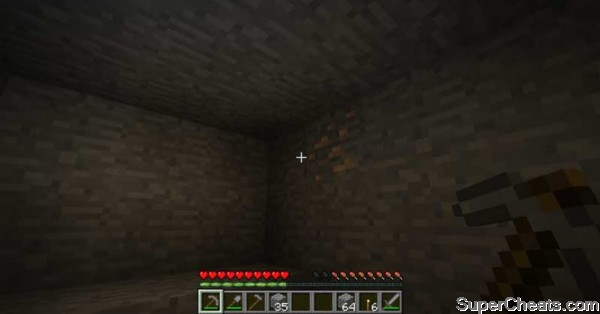
-- Iron Ore
While it is not really an uncommon ore to be found, it is certainly not found as often or as easily as most players would like... Iron Ore appears from the level of 2 to around 65, which means you will have to do some digging down to get to it, and it is usually encountered among Stone, and tends to appear in clusters of 2 to 8 or so. Any Pickaxe from Stone up will do for mining it.
Iron Ore is used to create Iron Ingots, which in turn are used to create an incredible variety of useful tools, weapons, and kit. Generally speaking you will use more Iron than any other resource for making tools and mining items such as Tracks and Carts, so you will want to mine any and every Iron Ore you encounter.
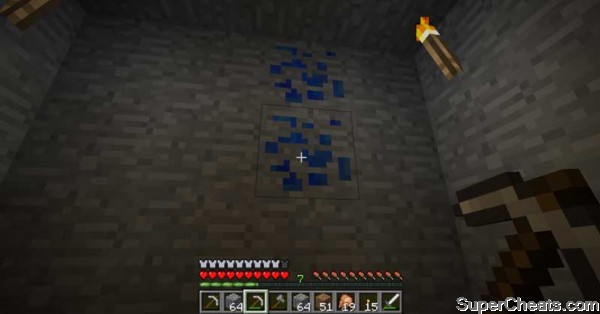
-- Lapis Lazuli
One of the stone-based resources in the game, Lapis is largely used as a decorative material, as it can be mined and then combined into Lapis Lazuli Block that can be used to simulate water in your den, used as a floor tile, and is a popular ceiling block for creating sky scenes. When it is used as a dye it must be fired in a Furnace first, and can be either applied to Wool Blocks in the Crafting Window, or applied directly to Sheep to transform them into colored Sheep.
Obtained in mines at Level 31 and deeper, Lapis breaks up into small chunks of Lapis Stones, with an average of betwen 4 and 8 small chunks spawning from mining a Lapis Lazuli resource block.

-- Leather
Added to the game at the same time as Cows were (you obtain Leather by killing Cows), this resource is used in crafting the lowest tier of Armor in the game, though often enough if the player happens to spawn in the center of a primary map that does not contain Cows, Iron ends up being their first Armro Tier.
When you kill a Cow there is a small chance that it will drop no Leather at all, but more often it will drop from 1 to 2 pieces of Leather. If your map contains Cows and, naturally you want to create a set of Leather Armor, you will need to obtain a total of 24 pieces of Leather to craft the full set. Bear in mind that while Leather Armor is not the most durable, or the most protective, it is better than no Armor at all.
-- Melon Seeds
Obtained as loot from treasure chests -- and ONLY from treasure chests -- once you have Melon Seeds you can plant them and then get future seeds by breaking down a Melon Slice.
-- Nether Wart
A plant that only grows in The Nether, and then only when planted on Soul Sand, Nether Wart is presently used in the game as an ingredient for Brewing Awkward Potions, which considering that they are the base potion for ALL of the other potions, this makes Nether Wart a very important resource and one that players will want to stockpile whenever they encounter it.
Considering that Nether Wart is only grown in The Nether, farming it is more a practice of harvesting it where it is found and then replanting it there so that the player has a known harvesting spot that they can return to. The reason for that is simply because while you can plant it in Soul Sand anywhere, it will only actually grow in The Nether.
When planted in The Nether the Wart has four stages of growth, with the middle-two appearing to be identical. The final stage, which is when it is ready to be harvested, reveals the image of the wart on the plant. If there is no wart, then you do not harvest.
-- Nether Wart Seeds
Obtained from Nether Wart -- a mature Nether Wart plant will yield between 2 and 5 Nether Wart Seeds -- it is the Seeds that are the actual ingredient that is used for crafting (brewing) potions. Read the entry for Nether Wart to learn the limitations for growing this plant from seeds.
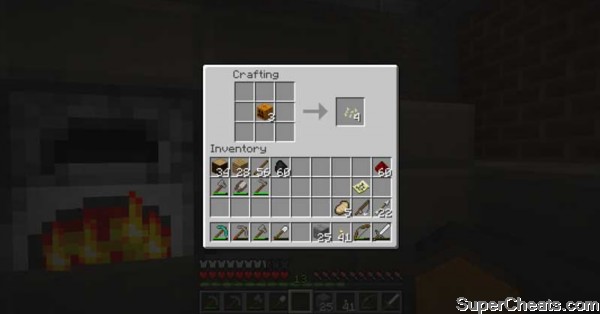
-- Pumpkin Seeds
Obtained by placing a Pumpkin on the Crafting Window or by harvesting a Pumpkin Vine, you plant these in tilled and irrigated soil with an open space next to each row in order to allow the fruit to spawn. Maintaining a supply of seeds for your Pumpkin farming is a simple matter of setting aside some of the fruit from each harvest and removing the seeds from them, to be placed in your stockpile and used when a mature vine has died.
Generally once your vine has matured and begins producing fruit it will continue to do so until it dies naturally or is destroyed. Pumpkin Vines can be destroyed prematurely in a number of ways -- Skeletons are known to destroy them by walking on top of them, and vines that are caught in the radius of a Creeper explosion will also die of course. While they are a robust plant and can be walked upon by the player usually without damage, it is possible to destroy a vine by walking on it too much.

Generally speaking most farmers prefer to create a dedicated Pumpkin patch area in which orderly rows of vines are laid out with adequate room for the fruit to spawn adjacent to them, and the entire patch is then placed behind a fence or fences in order to protect it from mob damage. Any enclosed (fenced in) farmyard should also be given an adequate light plan so that it does not contain areas in which Mobs may spawn at night, as otherwise fencing it in is rather pointless.
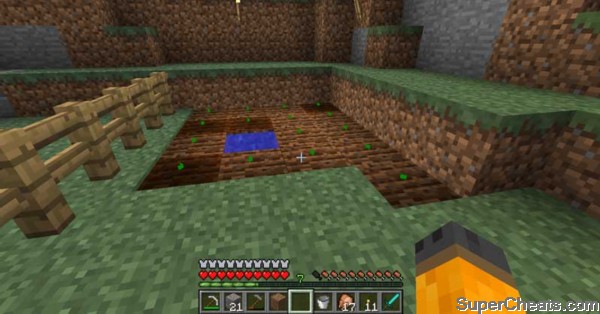
In the image above you see an example of the wrong way to plant a Pumpkin patch -- if you plant them in this fashion you will only obtain a very small number of fruit as a result, because the vines require an open space of grass, dirt, or sand in order to actually spawn the fruit itself. As you can see in the image above, the only vines in this patch that have access to open space are the four in the front of the patch, so ONLY those four will begin producing fruit once each vine has matured.
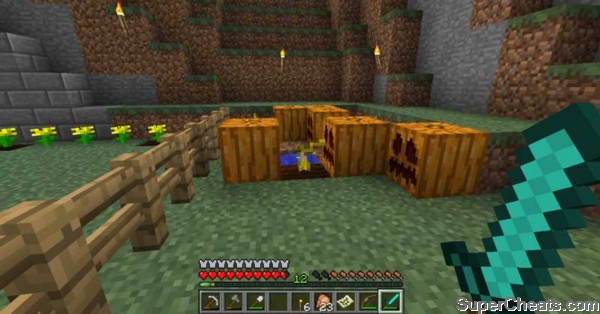
As you can see in the image above, open rows have been created to allow the vines the room to spread and spawn their fruit.
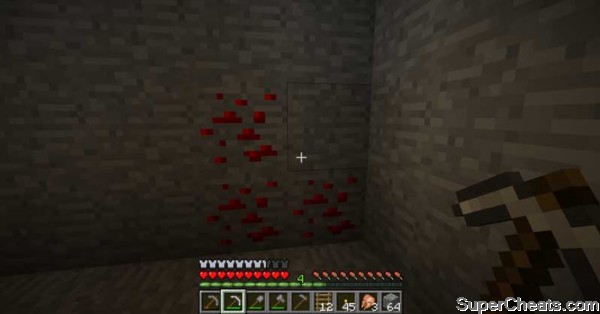
-- Redstone Dust
One of the few resources in the game that is used both for Crafting and for Brewing, Redstone Dust is obtained by mining Redstone Ore (see the entry for Redstone Ore for more details).
For Crafting purposes, Redstone Dust is used in making Redstone Torches, Redstone Repeaters, Clocks, Compasses, Note Blocks, Pistons, Redstone Lamps, and Dispensers. In addition it is also used for the Crafting of Powered Rails and Detector Rails.
For Brewing purposes, it is used for the Mundane Potion. It can also be placed on the ground to create Redstone Wire, which is used to connect Switches to Powered Rails among other functions.
-- Redstone Ore
A fictional mineral with magnetic and conductive properties, Redstone Ore is the basic form that Redstone takes in the game when a world is created. All of the subsequent forms and uses begin with mining the Ore, after which it is either Crafted or Brewed to create its other forms.
When the Ore is encountered it must be mined with an Iron Pickaxe or better, and the average yield of a Redstone Ore is 4 to 5 pieces of Redstone Dust. The Ore is encountered in the bottom 16 layers of the map, and once the player has reached those levels, is not uncommon and in fact is rather easy to find. Often it will be found near Gold Ore and Diamond Gems, so striking out around the area is generally considered to be a smart move.

-- Slimeball
Dropped by Slimes in quantities of up to two each, as of now the only uses in the game for Slimeballs are for creating Sticky Pistons, and for creating Magma Cream -- and as Magma Cream is a highly desirable item in the game (for Fire-Resist Potions) that makes Slimeballs a highly desired item that most players consider a natural for stockpiling.

-- String
Acquired from Spiders, who drop up to two pieces when killed, String is a core ingredient in making Fishing Poles and Bows, and can be used to craft blocks of Wool, but that last is a very inefficient use of this resource considering how easy and plentiful Wool is to obtain from Sheep.
In addition to being sourced from killing Spiders, String can also be obtained by destroying Cobwebs and can be found in dungeon chests.
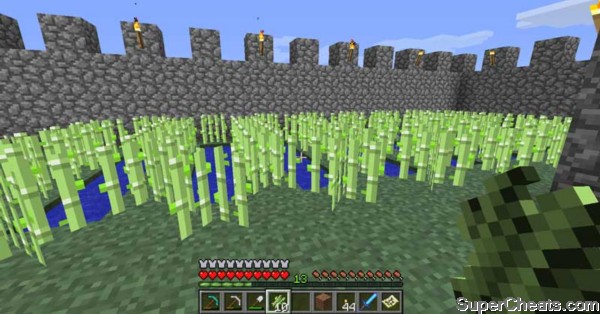
-- Sugar Cane
A plant that is found growing on the edge of water (and can only be planted and grown on the edge of water) Sugar Cane can be harvested and then planted next to water in your Stronghold. Planting one piece of Sugar Cane and allowing it to grow will produce a plant three-blocks tall; you can then harvest the top two stalks leaving the original base stalk in place so it can grow more, providing you with a never-ending supply of Sugar Cane, which can be crafted into Sugar for cooking, and paper for crafting.
In the image above you can see the basic layout for a Sugar Cane Farm -- long slit trenches are dug into the earth and then filled with water, and rimmed with either dirt or sand so that the Sugar Cane plants can be planted in the dirt/sand along the edge of the water (the only place that Sugar Cane can be planted in the game).
The single base plant is never actually harvested by the player -- instead it is allowed to grow, and when it is fully grown will produce two more plant sections above, which are harvested. By leaving the base section in place after harvest you allow it to regrow again and again, which means you only ever have to plant the base plant once.
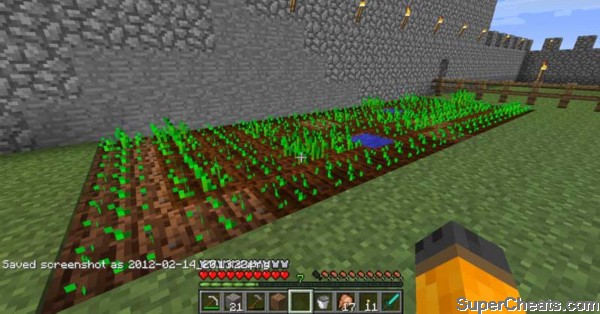
-- Wheat Seeds
Obtained by crushing Tall Grass, Wheat Seeds are planted in tilled and irrigated soil to grow Wheat, the harvesting of which will produce Wheat for cooking as well as additional seeds for planting more crops.
The layout of the average Wheat Field should look something like this -- with the "W" representing a block planted with Wheat, and the "I" representing an Irrigation Hole filled with Water. Note that an Irrigation Hole will fully-irrigate all of the blocks in every direction for up to four blocks, and partially irrigate an additional two blocks in distance -- however placing Irrigation Holes closed together will NOT have a negative impact on your crops.
WWWWWWWWW
WWWWWWWWW
WWWW I WWWW
WWWWWWWWW
WWWWWWWWW
All of the Wheat in the above formation will be properly irrigated, so a field can simply be constructed by duplicating the structure above as a grid.
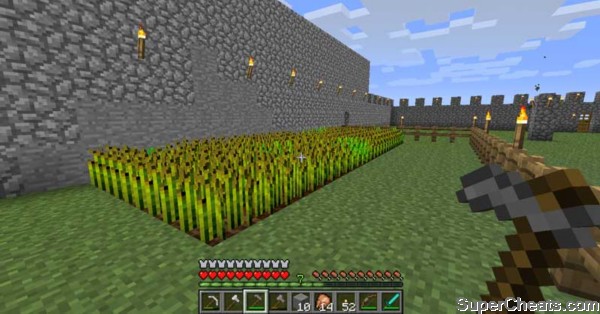
Fully mature Wheat plants will be... Well... Wheat-colored. Immature Wheat plants will retain a green hue in their color. Generally speaking there is no harm in waiting until the entire field is mature before you harvest it -- there is no penalty for that.
Wheat can be used for making Bread and Cake, and in the future there are plans to add a flour mill and four-based recipes to the game, which will add to the value of being a Wheat farmer. Harvesting your Wheat crop should result in obtaining a renewable supply of seeds as some of the plants will yield Wheat and seeds, but bear in mind that you can always harvest a new seed supply as needed from Tall Grass.
Anything missing from this guide?
ASK A QUESTION for Minecraft
Comments for Resources and Raw Materials
Add a comment
Please log in above or sign up for free to post comments- Walkthrouhs
 Join us on Discord
Join us on Discord

That is a very inefficient way to grow wheat. It may give tons of wheat for its size, but planting in rows is MUCH faster.
I am getting minecraft for the computer and now I know what to do in my mines and while I smelt my ores!
-alex piatt
i just got minecraft for xbox and is there diff resources like sliver or like other kinds
i think there awsome facts very usefull